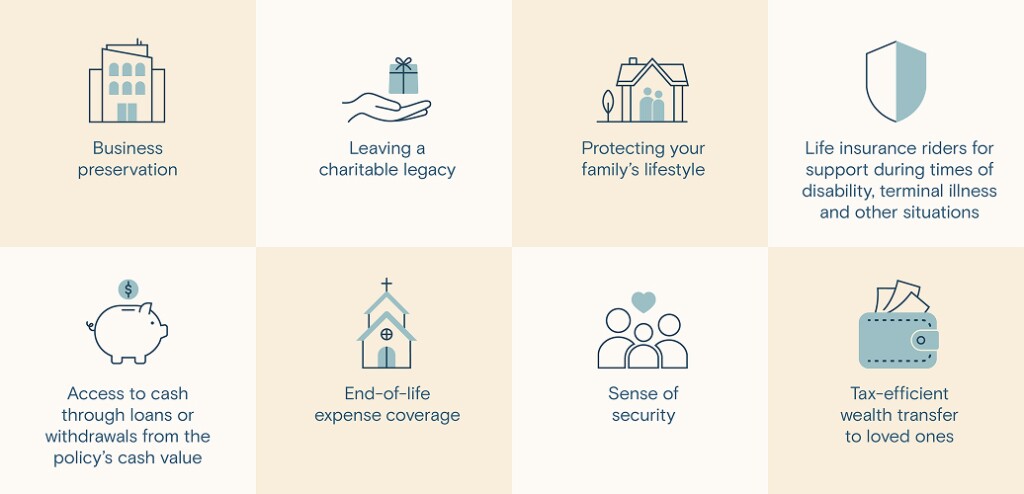Wondering if you can have more than one life insurance policy? The short answer is yes, but there are some limitations, potential efficiencies and other factors to consider.
Life is full of change, and your financial needs evolve. Even with
Here's what you need to know about taking out a supplemental contract.
Strategies for multiple life insurance policies: Supplementing & laddering
Your life insurance needs will likely change dramatically during your lifetime. You may need more protection in early adulthood—especially if you're married or have children—and less as you reach your 50s or 60s. Supplementing and laddering are two common strategies for using multiple life insurance policies that can help ensure you and your family always have the right level of coverage.
Supplementing life insurance
It often makes sense to buy
If your permanent contract has a
Should your insurance needs increase later in life—such as when you're raising children—you can supplement your permanent contract with term insurance that gives you and your family additional, temporary coverage during your highest-spending years. Later, when you become an empty-nester or retire, you may not need that extra protection anymore and can let the term insurance reach an end. But your permanent life insurance will still be there to tap into for
Laddering life insurance
Another common life insurance strategy is to create a "ladder" of multiple, overlapping
The advantage to this is that you're more likely to lock in lower rates when you're young, before your health factors have changed due to aging or the onset of new issues. The laddering strategy aims to provide your spouse or co-parent with the most protection in the early years of raising your child. Then, the combined coverage gradually decreases as your child reaches adulthood and can support themself.
How many life insurance policies can you have?
Technically, the number of life insurance contracts you can own is unlimited, but insurers check your total coverage before issuing more. As long as you're within their insurability limit—which varies widely among companies—you may be able to buy another contract from the same insurer. If not, you may need to shop around for a different carrier if you feel you need more coverage.
Here are a couple of factors to consider when you're thinking about how many life insurance contracts you want:

Your age & income may limit your total multi-contract coverage
Companies set their total insurability limit based on your overall financial picture. Generally, the younger you are and the more income you have, the higher the ceiling is on potential coverage across one or more contracts. However, the insurer may also look at other factors, such as whether or not you own a business that's likely to continue after your passing.
You may decide less is more due to pricing tiers
It might make more financial sense in some cases to buy a new contract that replaces your existing coverage. Companies use pricing tiers called breakpoints when calculating their premiums. For instance, the insurer may have breakpoints of $1 million, $250,000 or $100,000. Your cost per thousand dollars of death benefit generally decreases when you purchase larger amounts of coverage. This means it might be more affordable to buy a $1 million contract through one company rather than having several smaller contracts at separate ones.
However, buying a bigger contract doesn't always result in lower total premiums. If you bought your first contract at a much younger age—or before you developed a health issue—your new contract will likely be more expensive.
When should you consider multiple life insurance policies?
Your financial obligations and budget can change significantly during your life, and your insurance needs will likely shift, too. Buying additional coverage can be important in a number of situations such as these:
You experience a significant life event
If you get married or have a child, for example, you may need
Your income has gone up
Even if you dutifully purchased as much life insurance as you could afford during those first significant life events, like marriage and having children, your financial situation is likely to change as you develop your professional life, too. If your income has grown since you first bought life insurance, you may not have the amount of protection your loved ones need to maintain your evolving lifestyle. It's a good idea to reassess your life insurance needs as your income increases and consider additional, overlapping coverage for any gaps.
You own or have a key role in a business
If you have your own business, are a member of a partnership or hold an important role in a company, you want the other stakeholders to be able to keep up operations after you die. They may need funds to pay for extra help until they find a suitable replacement for you. Even if you have life insurance that provides for your family, you may want to add
You want to cover your final expenses yourself
Making final arrangements can be a significant financial challenge for your loved ones. Coordinating your coverage with a thoughtful combination of permanent and term life insurance contracts can help make your remaining debts and funeral costs easier to manage.
Finding the right coverage for your specific needs
Whether you decide to replace your existing life insurance contract with a larger one, or take out a new one with different benefits to complement what you have, increasing your coverage can help financially protect the people you love. A







